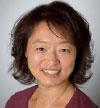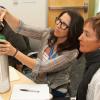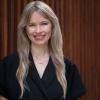
The Mouse That Roared: Doctoral Program in Sociology Continues to Make Its Mark
To celebrate the 150th birthday of UC San Francisco and the role that the School of Nursing has played in this unique health sciences institution, Science of Caring is running a series of stories that focus on important, often seminal contributions that the School has made to health care delivery, education and research. For more than 40 years, the doctoral program in sociology has been delivering a steady stream of such contributions.
Note: An earlier version of this article appeared in Science of Caring in 2009.
“I like to refer to this program as The Mouse That Roared,” says Virginia Olesen, professor emerita in the Department of Social and Behavioral Sciences at UC San Francisco School of Nursing. “This has always been a tiny program – never more than six or seven faculty. But, my gosh, the contributions.…”
These contributions include legitimizing the concept of nursing research, establishing today’s most prominent qualitative research methodology and informing the most significant public discussions about health and health care in the past half century, from women’s health and health disparities to aging and the impact of science and technology.
The Beginning
 In 1960, School of Nursing Dean Helen Nahm was determined that graduate programs in nursing would not just prepare nurses for leadership positions in nursing education and service, but also conduct research informed by nurses’ own unique worldview.
In 1960, School of Nursing Dean Helen Nahm was determined that graduate programs in nursing would not just prepare nurses for leadership positions in nursing education and service, but also conduct research informed by nurses’ own unique worldview.
At the time, Anselm Strauss was already emerging as one of sociology’s leading lights, but his focus, medical sociology, was a barely recognized specialty. Strauss, however, seemed to grasp before many others did how profoundly developments in health care after World War II – among them government money flowing into both physical and mental health services, the rise of employer-based health insurance and the emergence of what has come to be known as medicalization – would change not just the thrust of his discipline, but all of American society.
When Nahm approached him, Strauss was conducting a study at a Chicago mental institution, exploring aspects of health care that were mostly hidden.
“Anselm was studying everyone, looking at the lived experience of the patient on the one hand and issues of professional socialization on the other,” says Adele Clarke, a student of Strauss’ who has been a faculty member in the department since 1989 and is now a professor emerita. “He was already taking nurses and other health care workers’ contributions seriously. And everyone since then has understood that there are people besides physicians who contribute to healing and health – even patients themselves and their families.”
Nahm had found the right person at the right time. Even as Strauss began to teach graduate nursing students about research fundamentals, he and Nahm secured a number of National Institutes of Health grants, including one that examined the socialization of student nurses and, eventually, one targeted at developing nursing research. Within a couple of years, those grants lured to the School of Nursing people like Olesen, Fred Davis, Barney Glaser, Leonard Schatzman and Egon Bittner, all of whom would make their mark on both nursing and sociology.
Creating the Foundation
“Initially,” says Clarke, “we focused on the sociology of medical work – how it was organized and what it accomplished.”
“We also looked at aspects of health that other programs did not consider, like fitness programs,” says Olesen. “We took a very broad view.”
“The program really provided the foundation within our discipline for the study of health and illness,” says Howard Pinderhughes, associate professor in the Department of Social and Behavioral Sciences.
Two important constructs characterize that foundation: symbolic interactionism and grounded theory. The former is a sociological theory focused on how people interpret the world around them and act on the basis of those interpretations. The latter turns scientific inquiry on its head. Rather than beginning with a theory and then testing it through research, in the grounded theory method, sociologists substantively study a topic and then develop theories based on the data they accumulate. Today, says Clarke, grounded theory is the qualitative methodology used most in social science and nursing research.
As the intellectual foundation took shape – and the theoretical and methodological approaches expanded – the institution found new ways to support the work. The UCSF doctoral program in sociology became a permanent fixture in 1968, when an infusion of money from the state to the University of California system enabled the School of Nursing to hire more full-time faculty. Then, when the School established departments in 1972, the sociology program found a home in the newly formed Department of Social and Behavioral Sciences.
Understanding and Shaping Society
The program’s first mark was on classic medical sociology, including the work of Strauss and his associates on nursing roles and work by Carolyn Wiener on the technologized hospital.
Then, in the early ’70s, with the emergence of the women’s movement, Olesen, Sheryl Ruzek and others began looking at the treatment of female patients, as well as at nurses as undervalued professionals. In 1975, with federal support, the department organized the first social science conference on women’s health in the United States, which Clarke attended.
“Ginny and Adele then really spearheaded the link between feminism and women’s health,” says Pinderhughes. Later, Pinderhughes’ own work helped establish violence as a health issue in medical sociology.
During the late ’70s, Carroll Estes, along with Charlene Harrington, Bob Newcomer and Patrick Fox, established a specialty in aging. Through their work and the founding in 1979 of the Institute for Health & Aging (which was then called the Aging Health Policy Center), they established UCSF as an international leader in the sociology of aging. That work led almost directly to a new specialty area: health policy. To this day, the program’s research consistently informs policymakers and the public on everything from nursing homes and long-term care to disability, home care, Social Security reform and the social isolation of elders.
“One of the hallmarks of this department has been the way it established a clear link between scholarship and health policy,” says Pinderhughes. “We began doing public sociology far ahead of the curve.”
Another specialty area emerged in the ’90s, when Clarke and others began to examine the impact of biomedical science and technology on not just health care, but society as a whole. Early work examined brain localization and reproductive sciences; more recent work has looked at such topics as stem cell research, biomonitoring, erectile dysfunction drugs, information technology and genomics.
 Janet Shim Today’s efforts include the work of current sociology program director Janet Shim on the uses of race and ethnicity in research examining the interactions between genes and the environment, the work of Catherine (Rina) Bliss on a new racial consciousness in genome science and that of faculty member Barbara Koenig, who recently became co-director of the newly established Center for Transdisciplinary ELSI (Ethical, Legal, and Social Implications) Research in Translational Genomics.
Janet Shim Today’s efforts include the work of current sociology program director Janet Shim on the uses of race and ethnicity in research examining the interactions between genes and the environment, the work of Catherine (Rina) Bliss on a new racial consciousness in genome science and that of faculty member Barbara Koenig, who recently became co-director of the newly established Center for Transdisciplinary ELSI (Ethical, Legal, and Social Implications) Research in Translational Genomics.
“Barbara, Rina and myself are looking at how we can contribute to expanding the conversation around the directions of genomic research…to help society understand, interpret and think proactively about those impacts,” says Shim.
Faculty members also continue to provide leadership in the areas of race, health disparities and globalization. Very early student projects in the program included the Latino-Latina health paradox and the Port Chicago disaster. Recent faculty work by Shim looks at epidemiology’s use of racial categories. Pinderhughes’ latest work examines the chronic health problems engendered by the post-traumatic stress of living in communities beset by violence. Shari Dworkin – newly named associate dean for academic affairs at the School – examines gender relations, economic empowerment programs and HIV/AIDS prevention in Africa. And Zachary Zimmer uses a global lens to study the effect of rapid social change on the health and well-being of older adults.
A Lasting Contribution
“From the beginning, this group has really opened up the ways medical sociologists and social psychologists look at health and illness,” says Olesen.
“At a time when one of the most important issues is health care reform, part of the legacy of this department is to do cutting-edge research around things like the health care system, the patient’s experience, inequalities and end of life,” says Pinderhughes.
He further notes that the impact goes beyond the policymaking arena to social movements such as those that grew up around HIV/AIDS, breast cancer and environmental health. The use of credible research to dispel stigma, affect policy or challenge how a disease is understood has often changed how everyone – from medical professionals and politicians to employers and family members – views patients and disease.
“That’s happening on a very broad scale,” says Shim. “All of these conversations are about how we understand disease, health and well-being. Is it about genetics? Social environment? Zip code? The way we get treated by other people? How much is it one as opposed to the other? It’s part of a historical trend, where more and more folks are feeling like we have the capacity and are entitled to ask questions of researchers and clinicians.”
The challenge, she adds, is that while people are asking the questions, the pace of change often means that the ability to interpret and digest the advances lags behind. “Having information only has meaning when we can interpret the information and agree on its meaning,” says Shim. “That’s Anselm Strauss’ tradition: What meanings do people attach to disease, biomedical information or having a particular illness? And how can we think about putting this into policies and programs that better account for these meanings?”
A Fertile Training Ground
The sociology program has also been a valued training ground for both sociologists and doctorally prepared nurses. “Most of our students find work as medical sociologists, either in government research or in higher education,” says Clarke. “Many have moved on to the best schools to teach, including London School of Economics, Brandeis and McGill. Doctorally prepared nurses, many of whom learned their research methods at least in part from the UCSF Department of Social and Behavioral Sciences, have gone on to positions of leadership at the finest schools of nursing in the nation.”
All of these accomplishments have occurred in a unique setting: the doctoral program in sociology is one of only a few of its kind in a school of nursing.
“It’s been a very congenial atmosphere,” says Olesen. “If you look through the dissertations, done over many years, and faculty research, they took a lot of vivacity from being here.”
“I would venture to say that it’s not happenstance that we are at the School of Nursing,” says Pinderhughes. “Nursing as a profession focuses on the provision of care versus the provision of medicine, a perspective that naturally values the type of research we conduct. There have been growing pains, but our theoretical stance and methodological grounding have been important parts of the evolution of the PhD program and of research at the School of Nursing. I think the relationship is only going to get stronger.”
“It’s a tribute to the School that it has a vision of social science as part of nursing education and nursing science,” says Shim. “Areas like global health, genomics and ethics, and the social determinants of health are all areas where nursing is seeking to grow. There’s a real synergy that can happen, both within our program at the School and with nursing science more generally, that helps us stay ahead of the curve and define our own areas of expertise. And in turn, our program’s location in a school of nursing on a health science campus has helped to shape our contributions to medical sociology, by keeping front and center important issues of care, professions, social inequality and social change and their impacts on health.”



